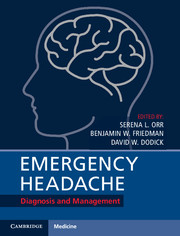Book contents
- Emergency Headache
- Emergency Headache
- Copyright page
- Contents
- Contributors
- Preface
- 1 Introduction
- 2 Epidemiology of Headache in the Emergency Department
- 3 Approach to History Taking and the Physical Examination
- 4 Approach to Investigations
- 5 Thunderclap Headache in the Emergency Department
- 6 Other Secondary Headaches in the Emergency Department
- 7 The Migraine Patient in the Emergency Department
- 8 The Patient with a Trigeminal Autonomic Cephalalgia in the Emergency Department
- 9 Other Primary Headache Disorders That Can Present to the Emergency Department
- 10 Medication Overuse Headache in the Emergency Department
- 11 Approach to the Pediatric Patient with Headache in the Emergency Department
- 12 Approach to Pregnant or Lactating Patients with Headache in the Emergency Department
- 13 Approach to the Elderly Patient with Headache in the Emergency Department
- 14 Preventing Emergency Department Visits in Primary Headache Patients and Prevention of Bounce-Backs to the Emergency Department
- Index
- References
3 - Approach to History Taking and the Physical Examination
Published online by Cambridge University Press: 09 October 2017
- Emergency Headache
- Emergency Headache
- Copyright page
- Contents
- Contributors
- Preface
- 1 Introduction
- 2 Epidemiology of Headache in the Emergency Department
- 3 Approach to History Taking and the Physical Examination
- 4 Approach to Investigations
- 5 Thunderclap Headache in the Emergency Department
- 6 Other Secondary Headaches in the Emergency Department
- 7 The Migraine Patient in the Emergency Department
- 8 The Patient with a Trigeminal Autonomic Cephalalgia in the Emergency Department
- 9 Other Primary Headache Disorders That Can Present to the Emergency Department
- 10 Medication Overuse Headache in the Emergency Department
- 11 Approach to the Pediatric Patient with Headache in the Emergency Department
- 12 Approach to Pregnant or Lactating Patients with Headache in the Emergency Department
- 13 Approach to the Elderly Patient with Headache in the Emergency Department
- 14 Preventing Emergency Department Visits in Primary Headache Patients and Prevention of Bounce-Backs to the Emergency Department
- Index
- References
Summary
The majority of patients presenting to the emergency department (ED) have non-life-threatening primary headaches such as migraine, tension-type, or cluster headache. It is important to differentiate this group from the smaller number of patients with a secondary headache disorder, which can be serious with potentially fatal outcomes.
A careful history and physical examination is the most important part of the evaluation of the patient presenting to the ED with headache. This helps to determine whether there is a significant risk for secondary headache and whether additional investigations are needed.
This chapter discusses how to approach adults who present to the ED with headache, with an emphasis on determining elements of the history indicative of an underlying secondary cause as well as important questions to ask patients presenting with a primary headache disorder. In addition, key elements of the general medical and neurological examination will be reviewed.
- Type
- Chapter
- Information
- Emergency HeadacheDiagnosis and Management, pp. 15 - 25Publisher: Cambridge University PressPrint publication year: 2017

